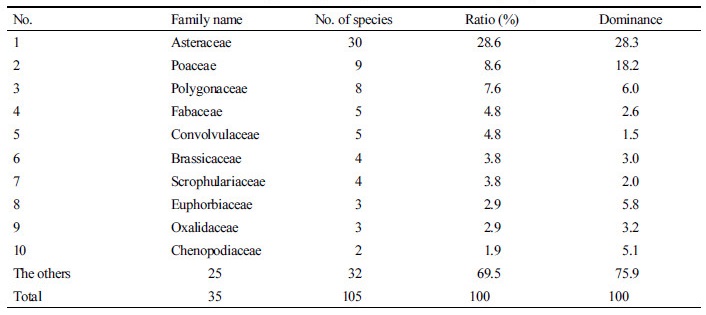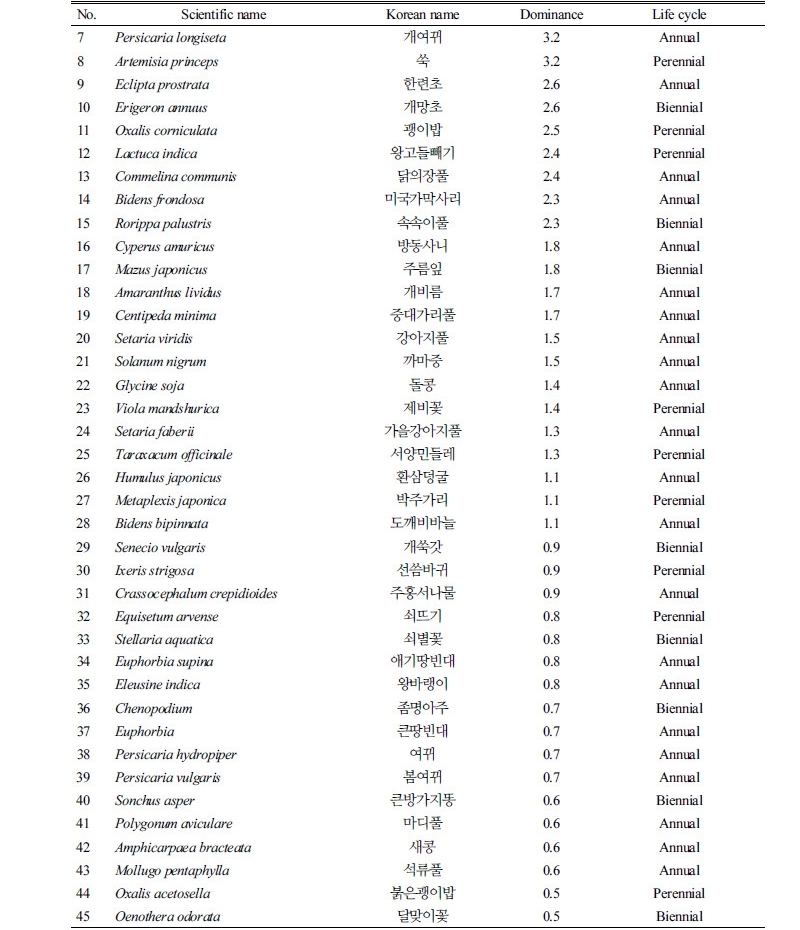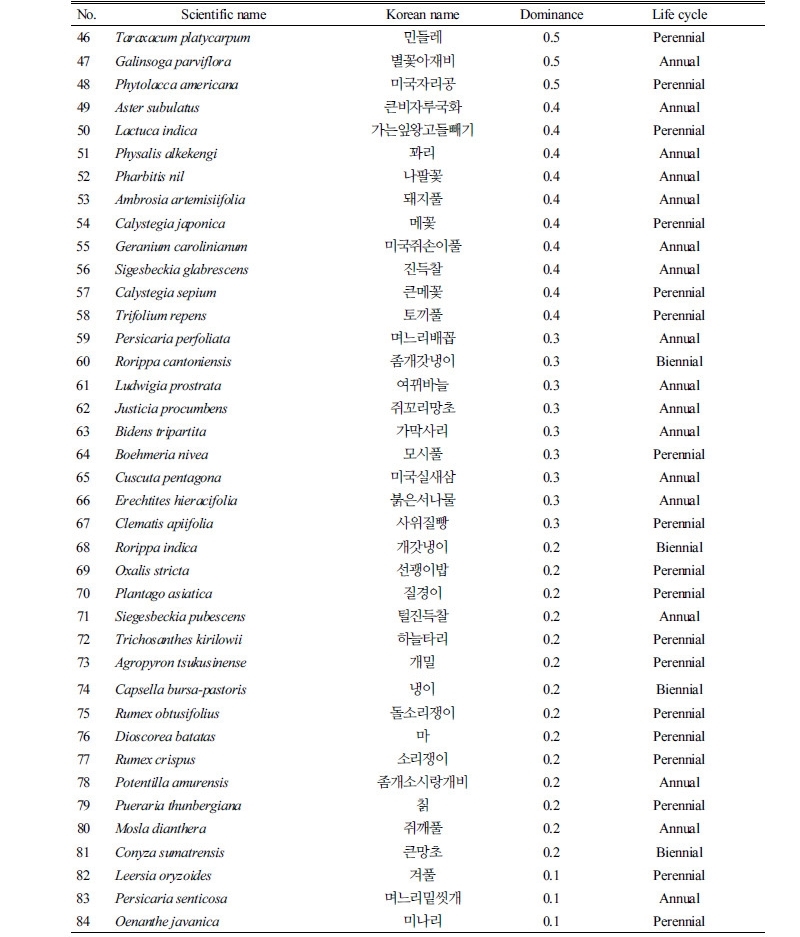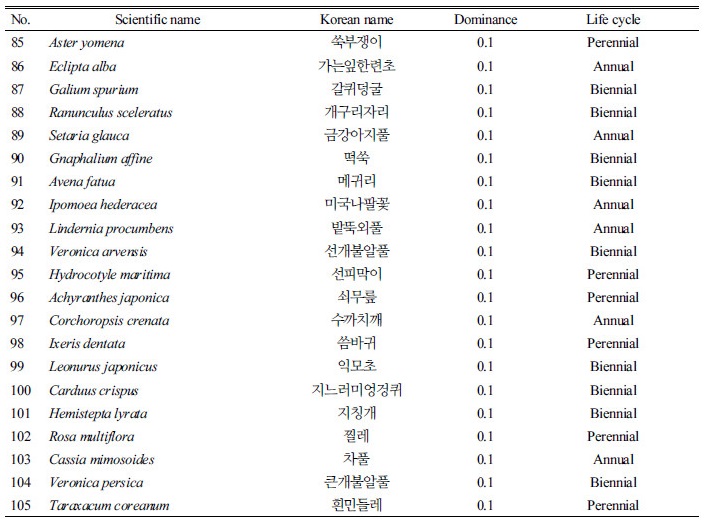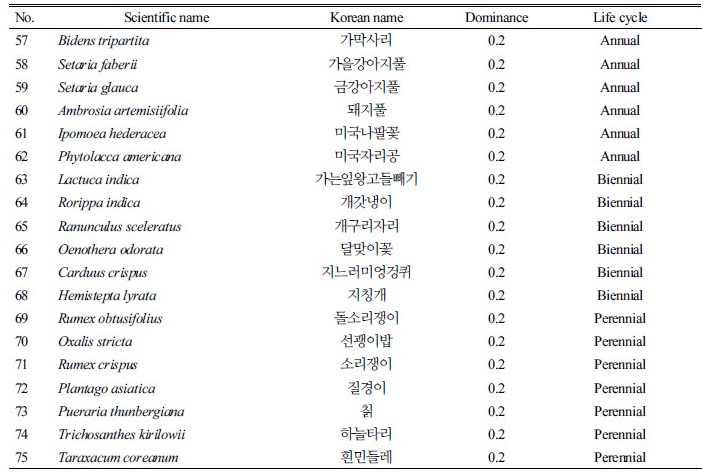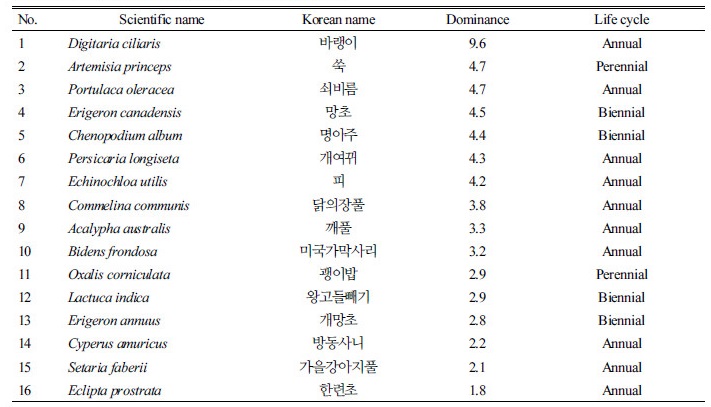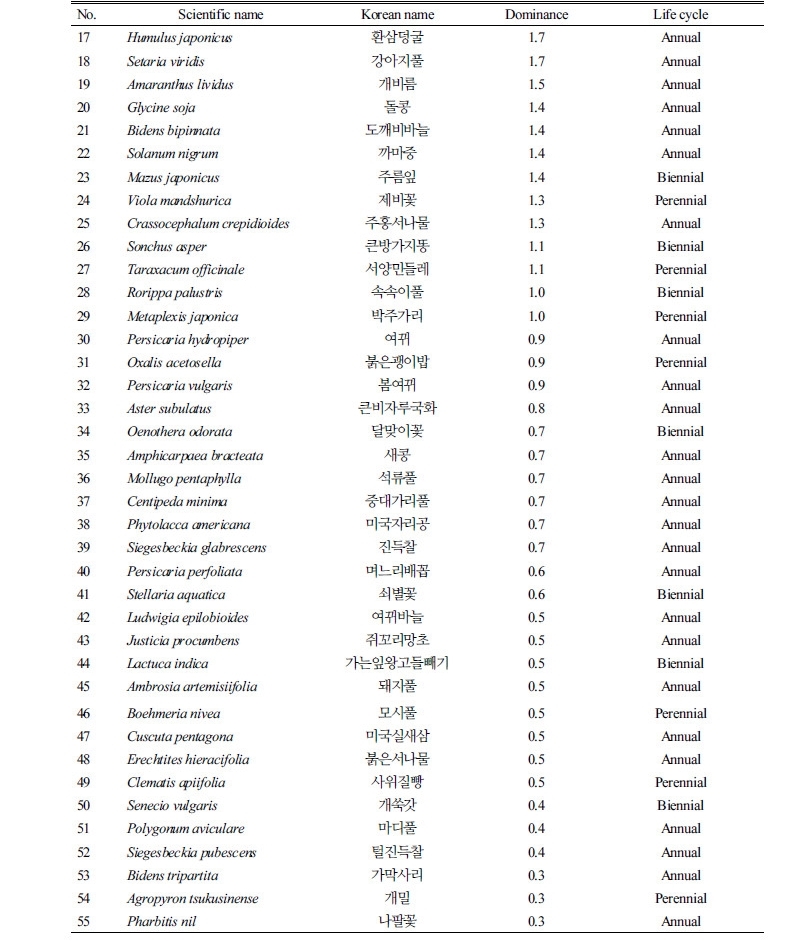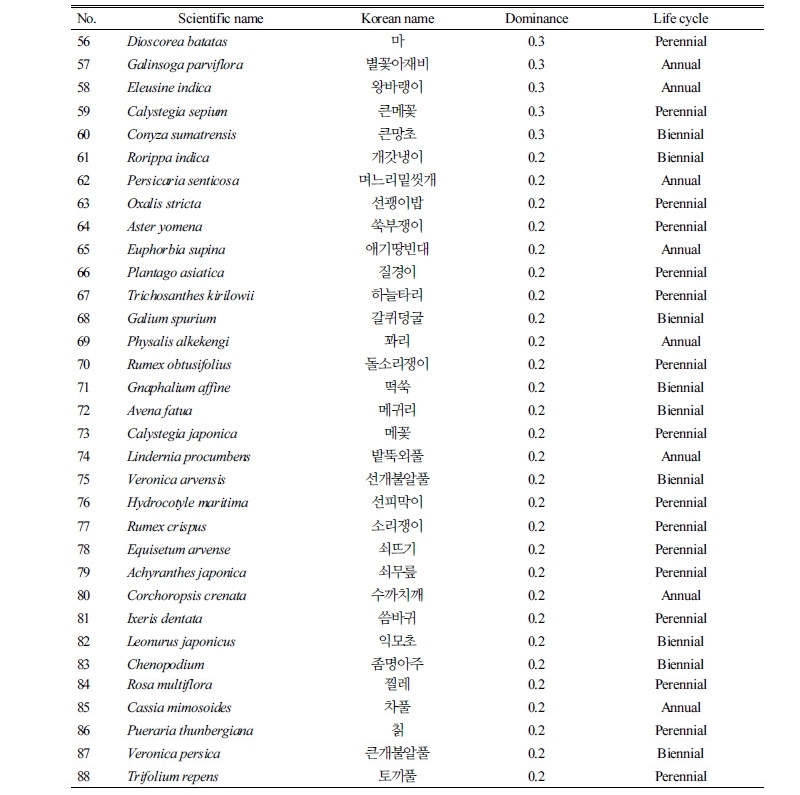서 론
잡초의 발생은 농산물을 생산하는 농업 경제적 활동에서 해가 되는 식물이라고 할 수 있다. 따라서 농업인은 자기의 경제적 활동 무대에서 방해가 되는 잡초가 어떤 것인지를 잘 파악하고 대책을 세워야 최소의 노력과 비용으로 농업 생산 활동을 지속 할 수 있을 것이다. 2010년대 국내 밭작물의 재배형태는 매우 다양하다. 크게는 노지재배와 시설재배로 나눌 수 있으며, 노지
재배도 피복재배와 무피복재배, 피복재배도 비닐피복 및 볏짚 등 식물 잔사 피복, 화학합성 피복자재 즉 비닐피복도 폴리에틸렌(PE) 투명 필름 및 다양한 유색 필름, PE 필름도 유공 및 무공필름, 부직포 등으로 재배방법이나, 형태가 다양화되어 있다. 잡초는 이런 재배형태에 따라 발생이나 생육이 다를 수밖에 없다. 또한 작물의 종류(Yoo et al., 1995), 재배시기 등 재배방법(Im et al., 1993a, 1993b; Kuk et al., 2002), 재배 토양관리(Guh et al., 1983), 환경(Suzuki and Suto, 1975; Okafor et al., 1976; Lee and Pyon, 2001) 등에 따라서도 다르다. 특히 기계적제초, 화학적제초 등 제초방법 이나 사용 제초제의 특성(Kim et al., 1981)에 따라서도 큰 차이가 있다. 따라서 특정 작물의 재배지에서 잡초 발생 특성에 관한 연구도 최근까지 이루어 지고 있다(Lee et al., 2014a, 2014b; Kim et al., 2014; Lee et al., 2015).또한 특정 지역을 대상으로도 연구가 이루어지고 있으나(Oh et al., 2014; Choi et al., 2009; Hwang et al., 2013), 소면적 재배작물에 대한 연구 조사는 미흡한 실정이다. 따라서 본 연구는 한국에서 소면적으로 재배되고 있는 작약 주산지를 대상으로 잡초발생 특성을 조사하여 방제 기초자료로 활용하고자 수행되었다.
재료 및 방법
조사지역 및 조사방법
작약 밭에서 발생하는 잡초는 2015년 6-7월 중에 작약 주산지인 경북 의성 24, 청송 12, 전남 화순 13, 장흥 10, 강진 12지점 등 74지점에서 조사하였다. 조사방법은 Braun-Branquet (1964)에 의한 우점도의 판정기준으로 피도가 조사면적의 3/4 (75%) 이상을 점하면 5, 1/2 (50%)-3/4 (75%)를 점하면 3, 극히 개체수가 많던가, 적어도 조사면적의 1/20 (10%)-1/4 (25%)를 점하면 2, 개체수는 많지만 피도가 1/20 (10%) 이하로 출현하면 1, 극히 낮은 피도로 나타나며 약간의 개체수가 출현하면 +, 극히 드물게 최소 피도로 출현하면 r로 7 등급화 하여 조사하였다.
조사결과 분석
잡초조사 결과는 국가표준식물목록(Cho et al., 2007)에 의거하여 목록을 작성하였다. 조사한 잡초종에 대해서는 Raunkiaer (1934)의 생활형을 기준으로 일년생과 다년생을 구분하였다. 조사결과를 바탕으로 잡초의 우점순위를 알아보기 위하여 중요치(IV)분석을 실시하였다(Curtis and McIntosh, 1950). 빈도는 전체 방형구 수에 대한 특정 종이 출현한 표본의 백분율로, 특정 종이 출현한 조사구 수를 총 조사구 수로 나눈 후 100을 곱한 값이며, 상대빈도(RF)는 특정 종의 빈도를 모든 출현 종의 빈도 총합으로 나눈 값에 100을 곱하여 구하였다. 상대피도(RC)는 특정종의 피도 합을 출현한 모든 종의 피도 총합으로 나눈 후 100을 곱하여 구하였다. 우점도(중요치:IV)는 상대빈도와 상대피도의 합을 2로 나누어 값을 구하였다(Important value (IV) (%) = (RF+RC)/2).
결과 및 고찰
작약밭 잡초발생 특성
한국 내 작약 주산지에서 잡초의 발생 특성을 파악하기 위하여 조사한 결과, 전국 작약 밭에서 발생하는 잡초는 35과 105종이었다(Table 2). 생활형별로는 일년생잡초는 49종이 발생하여 47%, 월년생잡초가 23종 발생하여 22%, 다년생잡초가 33종 발생하여 31%를 차지하였다(Table 1). 이러한 결과는 전국 전작물 재배지 잡초조사 결과 종수로 일년생 42%, 월년생 22%, 다년생 36% 정도의 비율을 보였다(Chang et al., 1990)는 보고와 유사한 경향이었다. 이는 현재까지 밭에서 잡초방제에 사용할 수 있는 제초제가 극히 제한되어 있어 소면적 재배 작물의 경우 거의 손제초의 위존도가 크기 때문에 발생잡초의 변화가 적었기 때문으로 생각된다.조사 잡초의 과별로 발생 양상을 보면 종수는 국화과가 30종으로 월등히 많았으며, 벼과 9종, 마디풀과 8종, 메꽃과 5종, 콩과 5종, 십자화과 4종, 현삼과 4종, 괭이밥과와 대극과 각각 3종, 가지과 등 나머지 과는 2종 이하로 발생하였다(Table 2). 이는 Park et al. (2003)이 전국 전작물 재배지에서 조사한 결과와 유사한 경향이었다. 발생 우점도는 국화과가 28.3으로 월등히 높았으며, 벼과도 18.2로 매우 높은 경향이었으며, 이 두 과의 우점도가 46.5로 거의 절반을 차지하고 있는 경향이었다. 작약밭에 발생하는 잡초의 우점도 3 이상의 상위 초종은 바랭이가 10으로 가장 높았으며, 쇠비름, 명아주, 깨풀, 피, 망초, 개여뀌, 쑥의 순이었다(Table 3). 대체로 발생 잡초의 초종별 우점도가 낮은 것은 작약 밭에서 여러 가지 다양한 잡초가 발생되고 있기 때문이라고 볼 수 있다.
경북 작약밭 잡초발생 특성
경상북도 작약 주산지에서 발생하는 잡초는 30과 75종으로 나타났다(Table 5). 이는 Kim et al. (1998)이 경북 작약 주산지에서 조사한 17과 33종보다 월등히 많은 초종이 발생하고 있었는데, 본 조사는 조사 표본의 집단이 크고 환경이 다양했기 때문으로 사료된다. 일년생잡초는 35종 발생하여 47%, 월년생잡초는 21종 발생하여 28%, 다년생잡초는 19종 발생하여 25%씩 차지하였다(Table 4). 1989년 전국 전작물 재배지 잡초조사 결과에서는 종수로 일년생 42%, 월년생 22%, 다년생 36% 정도의 비율을 보였으며(Chang et al., 1990), 생활형별 발생 종수의 비율에서 다소 차이를 보였는데 이는 경북의 작약밭은 중남부 지방으로 상대적으로 다년생잡초보다는 일년생잡초가 많이 발생하는 것으로 사료된다. 잡초의 과별 발생 양상을 보면 초종 수는 국화과가 20종(26.7%)으로 월등히 많았으며, 벼과 7종(9.3%), 마디풀과 6종(8%), 십자화과, 메꽃과, 콩과, 각각 4종씩(5.3%), 대극과 3종(4.0%), 명아주과, 가지과, 괭이밥과, 미나리아재비과 등은 각각 2종(2.7%) 씩의 순으로 발생하였다(Table 5). 발생 우점도는 국화과가 24.5으로 월등히 높았으며, 벼과도 18.1로 매우 높은 경향이었으며, 이 두개 과의 우점도가 42.7로 거의 절반을 우점하고 있는 경향이었다. 작약밭에 발생하는 잡초의 우점도 상위 10 초종은 바랭이가 10.6으로 가장 높았으며, 쇠비름, 깨풀, 명아주, 속속이풀, 피, 한련초, 중대가리풀, 망초, 주름잎 등 순이었다(Table 6). 대체로 발생 잡초의 우점도가 낮은 것은 여러 다양한 잡초가 발생되고 있기 때문이라고 볼 수 있다.
Table 4. Dominance and number of weed species by life cycle of weeds occurred in peony fields in Keongbuk region.

|
Table 5. Dominance and number of weed species by family of weeds occurred in peony fields of Kyeongbuk region.

|
전남 작약밭 잡초발생 특성
전남 작약 재배 주산지는 화순, 장흥, 강진이었으며, 작약밭에서 발생하는 잡초는 34과 88종이었다(Table 8). 일년생잡초는 43종 발생하여 49%, 월년생잡초가 20종 발생하여 23%, 다년생잡초가 25종 발생하여 28%를 차지하였다(Table 7). 과별로 잡초발생 양상을 보면 초종수는 국화과가 23종(26.1%)으로 월등히 많았으며, 벼과 7종(8.0%), 마디풀과 8종(9.1%), 콩과 6종(6.8%), 현삼과 4종(4.5%), 괭이밥과, 메꽃과 각각 3종(3.4%)씩, 명아주과, 대극과, 비름과, 가지과, 바늘꽃과, 십자화과, 미나리아재비과가 각각 2종(2.3%) 씩의 순으로 발생하였다(Table 8). 발생 우점도는 국화과가 30.3으로 월등히 높았으며, 벼과도 18.4로 매우 높은 경향이었으며, 이 2개과에 해당하는 잡초의 우점도가 48.7로 매우 높은 경향이었다. 작약밭에 발생하는 잡초의 우점도 상위 10 초종은 바랭이가 9.6으로 가장 높았으며, 쑥, 쇠비름, 망초, 명아주, 개여뀌, 피, 닭의장풀, 깨풀, 미국가막사리의 순이었다(Table 9).
Table 7. Dominance and number of weed species by life cycle of weeds occurred in peony fields in Jeonnam region.

|
Table 8. Dominance and number of weed species by family of weeds occurred in peony fields of Jeonnam region.
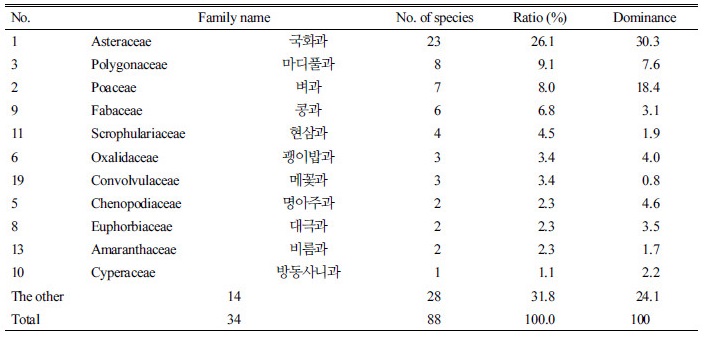
|
본 시험 결과 작약 재배지에서 생활형 등 다양한 많은 초종이 발생하고 있어 이에 따른 잡초방제 체계가 설정되어야 할 것으로 생각된다. 특히 작약 밭에서 작물 생육 중에 화본과 잡초는 선택적으로 방제할 수 있는 약제가 등록되어 있으나, 광엽 및 다년생잡초를 방제할 수 있는 등록 약제는 없는 실정이다. 따라서 작약 밭에 사용할 수 있는 제초제 등록이 우선이며, 이에 따른 방제체계 연구가 시급히 이루어져야 작약 재배시 생산비를 절감하여 농가 소득 증대에 기여 할 수 있을 것이다.


